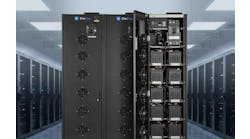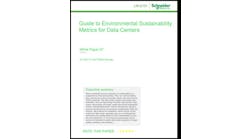Data Centers Deserve Full Transparency on Carbon Emissions from Suppliers
As global demand for data centers grows, sustainable solutions are increasingly vital. Emissions data, particularly related to Scope 3 emissions, plays a significant role in managing environmental impact. The responsibility for reducing emissions doesn’t fall solely on data center operators. Equipment suppliers must also take a proactive approach in measuring, tracking, and sharing emissions data.
A Commitment to Carbon Transparency
Sustainability is built on transparency, so we believe that information is power. With over 60 facilities in the U.S., ABB emphasizes clear communication and emission reporting across all regions and product lines. By leveraging third-party certifications and centralized sustainability reporting, we aim to hold products and their performance to a higher standard, breaking our metrics down by region, facility, and product line to enable data centers the ability to align data with their sustainability goals.
ABB provides detailed emissions data through the Carbon Disclosure Project (CDP), an internationally recognized platform supported by the United Nations, through which data center operators have access to their Scope 1, 2, and 3 emissions, along with water usage and waste management information. Additionally, ABB has committed to providing detailed data directly to its customers when requested. Through transparent sustainability reporting, we enable data centers to make informed decisions and drive progress toward reducing their carbon footprint.
Key Metrics for Data Centers to Consider
When data center operators calculate emissions, Scope 3 presents a visibility challenge because it includes the entire value chain, notably that of outside suppliers. Therefore, collaboration with manufacturers committed to decarbonization is essential. From materials sourcing to energy usage to how items are transported, every supplier decision can impact a data center’s Scope 3 emissions. It is critical to know granular details on energy usage, embodied carbon in materials, and upstream supply chain agreements when selecting a sustainable supplier for your project.
ABB focuses on reducing emissions by improving building efficiency, incorporating renewable energy, and addressing material and transportation impacts. We work closely with our own supply chain to obtain 80% coverage of emissions data and ensure accurate reporting. Globally, ABB has transitioned from a carbon-neutrality target, which allows for the use of carbon offsets, to net-zero, further advancing our goal of reducing climate impact.
Validation of Emissions Data
ABB’s emissions data is verified through the CDP platform, a third-party assurance process, and our EcoSolutions™ label is third-party certified, creating a centralized reporting system that is broken down by region, facility, and product line, allowing their sustainability goals with clear metrics. Additionally, ABB’s decarbonization targets have been approved by the Science Based Targets initiative (SBTi), a credible step to auditing and ensuring our environmental claims. This transparency enables data center operators to make informed decisions and trust that suppliers are making meaningful progress toward reducing emissions.
Technical Innovations Lead to Further Efficiency
ABB’s commitment to innovation supports our sustainability efforts. These proactive steps, taken without any legal requirement, are examples of our dedicated effort to reducing our carbon footprint.
In Pinetops, North Carolina, we implemented a complete capture system to capture and reuse SF6 gas from our Medium Voltage Switchgear, the only remaining product line in our portfolio still using the gas. This resulted in a 99.5% emissions reduction, comprising 13% of our U.S. carbon footprint.
The Megaflex LV UPS relied on voice-of-customer to be designed with energy efficiency in mind. Boasting a 40% footprint reduction compared to other configurations, it also offers operational modes that minimize energy loss and heat dissipation, thereby reducing electricity usage and cost.
ABB’s ANSI digital switchgear integrates newer concepts in product design, embedding technology to digitize protection and control. By using fewer raw materials such as copper wire and cable and incorporating sensors instead of traditional PTs and CTs, we have minimized material usage while maximizing operational efficiency, sometimes simulating entire switchgear compartments. This reduces the gray space needed for installations to enhance available white space.
Circular Economy Principles
In addition to emissions data, ABB provides its customers with a range of environmental data, from energy efficiency reports to life cycle assessments through annual ESG reports. These reports, accessible through the CDP platform or by request, offer a comprehensive look at ABB’s sustainability efforts.
ABB is embracing circular economy principles by integrating recycling and reuse into its product life cycle management so data centers can improve their Scope 3 emissions reporting. Through the EcoSolutions™ label, we can provide clear guidance on the steps to take when equipment reaches its end of useful life. ABB is also expanding efforts to include more recycled materials in its products and is exploring the potential for product take-back programs to ensure components and materials can be reused in the circular economy.
Meeting Industry Expectations
The data center industry has been a trailblazer in requesting emissions data and driving process innovation, setting a high standard for other industries to follow. As a critical equipment supplier, we value the importance of data and transparency and continue to align our factories, processes, and product roadmaps to ensure we do our part in decarbonizing digital infrastructure.
Our transparency, commitment to innovation, and proactive approach to reducing emissions make ABB a valuable partner for data center operators looking to meet their sustainability goals. With a focus on open collaboration as we navigate the challenges ahead, our industry can create a more sustainable future.
Sponsored by:
Natalie Silva: Strategic Marketing and Sustainability Leader, ABB
Natalie Silva is the Strategic Marketing and Sustainability Leader for Critical Power Industries at ABB, a global leader in electrical products and solutions. At ABB, Natalie creates the strategic roadmap for critical power infrastructure and market development across the electrification division. Prior to joining ABB, Natalie held leadership roles in product management and segment marketing in various industries. Natalie and her family reside in Raleigh, North Carolina.
Kevin Durocher: Sustainability Program Manager, ABB
Graduated from University of Connecticut in 2017 with a B.A. in Environmental Studies and a Minor in Women’s & Gender Studies. Joined ABB in June 2017 as an Environmental Intern. Began working full-time for ABB in 2018.
Kevin’s role focuses on:
- Sustainability within ABB’s operations; achieving carbon neutrality, zero waste to landfill, water reduction projects, and energy reduction projects.
- External reporting; Sustainability & ESG disclosures, Carbon Disclosure Project, EcoVadis, etc.
- Upstream and Downstream Operations; working with customers, transportation services, supply chain, and others to achieve sustainability goals.






